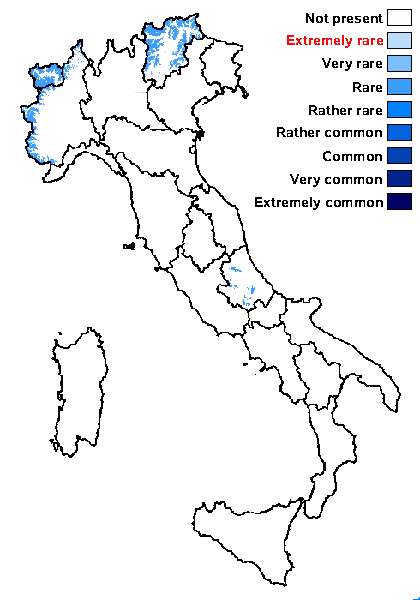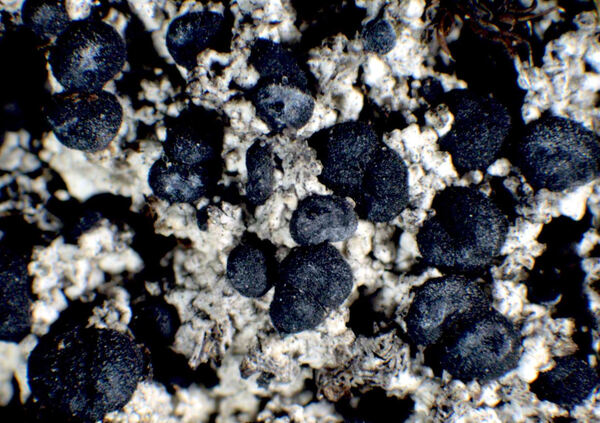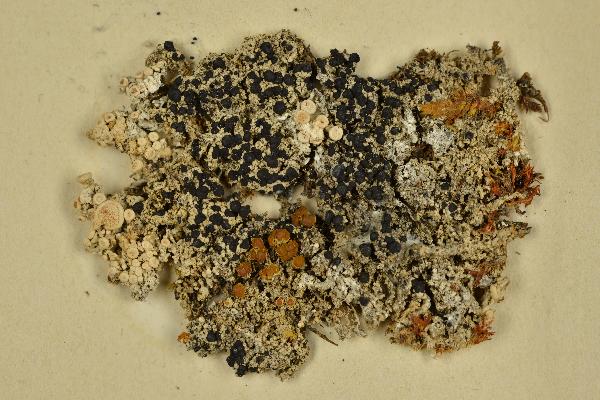Tetramelas geophilus (Sommerf.) Norman
Nytt Mag. Naturvid., 7: 236, 1853. Basionym: Lecidea geophila Flörke ex Sommerf. - Suppl. Fl. Lappon.: 157, 1826.
Synonyms: Buellia geophila (Sommerf.) Lynge; Buellia insignis var. muscorum (Hepp) Körb.; Buellia triphragmia (Nyl.) Arnold non auct.; Diplotomma geophilum (Sommerf.) S.R. Singh & D.D. Awasthi; Lecidea triphragmia Nyl. non auct.
Distribution: N - TAA (Nascimbene & al. 2022), Piem (Isocrono & al. 2004), VA (TSB 29476). C - Abr (Gheza & al. 2021).
Description: Thallus crustose, episubstratic, continuous to granulose-verrucose, white to grey-white, without a distinct prothallus. Cortex with calcium oxalate crystals: medulla white, I-. Apothecia lecideine, black, to 0.3-1.2(-1.5) mm across, immersed to sessile, with a flat to convex, rarely pruinose disc and a thin, finally often excluded proper margin. Proper exciple brown-black throughout, with rounded, thin-walled cells, the pigment giving a K+ yellow solution; epithecium brown, N-; hymenium colourless, not inspersed with oil droplets, 70-85(-100) µm high, I+ blue; paraphyses branched in upper part, the apical cell swollen, 4-5 µm wide, with a brown cap; hypothecium brown-black. Asci 8-spored, clavate to cylindrical-clavate, the apical dome K/I+ dark blue with a pale, conical-pointed apical cushion (axial mass), the wall I-, but the thin outer gel I+ blue, Bacidia-type. Ascospores 3-septate, dark brown, often curved, narrowly ellipsoid, (20-)24-38(-43) x 6-13 µm, the wall uniformly thick, indistinctly rugulate. Pycnidia rare, black, immersed in thallus. Conidia bacilliform, 4-6 x c. 1 µm. Photobiont chlorococcoid. Spot tests: thallus K- or K+ indistinctly yellow, C-, but C+ intensely yellow under the dissecting microscope, KC+ yellow to orange-yellow, P-, UV+ orange. Chemistry: 6-O-methylarthothelin. Note: a mainly boreal-montane to arctic-alpine, circumpolar lichen overgrowing terricolous and epilithic mosses on calciferous substrata, rarely corticolous, near and above treeline. A related species, Buellia trifracta J. Steiner, is known from the Alps of Austria.
Growth form: Crustose
Substrata: soil, terricolous mosses, and plant debris
Photobiont: green algae other than Trentepohlia
Reproductive strategy: mainly sexual
Commonnes-rarity: (info)
Alpine belt: rare
Subalpine belt: very rare
Oromediterranean belt: absent
Montane belt: absent
Submediterranean belt: absent
Padanian area: absent
Humid submediterranean belt: absent
Humid mediterranean belt: absent
Dry mediterranean belt: absent

Predictive model
Herbarium samples
Growth form: Crustose
Substrata: soil, terricolous mosses, and plant debris
Photobiont: green algae other than Trentepohlia
Reproductive strategy: mainly sexual
Commonnes-rarity: (info)
Alpine belt: rare
Subalpine belt: very rare
Oromediterranean belt: absent
Montane belt: absent
Submediterranean belt: absent
Padanian area: absent
Humid submediterranean belt: absent
Humid mediterranean belt: absent
Dry mediterranean belt: absent

Predictive model
| Herbarium samples |
 INDEX FUNGORUM
INDEX FUNGORUM
 GBIF
GBIF
 DOLICHENS
DOLICHENS





